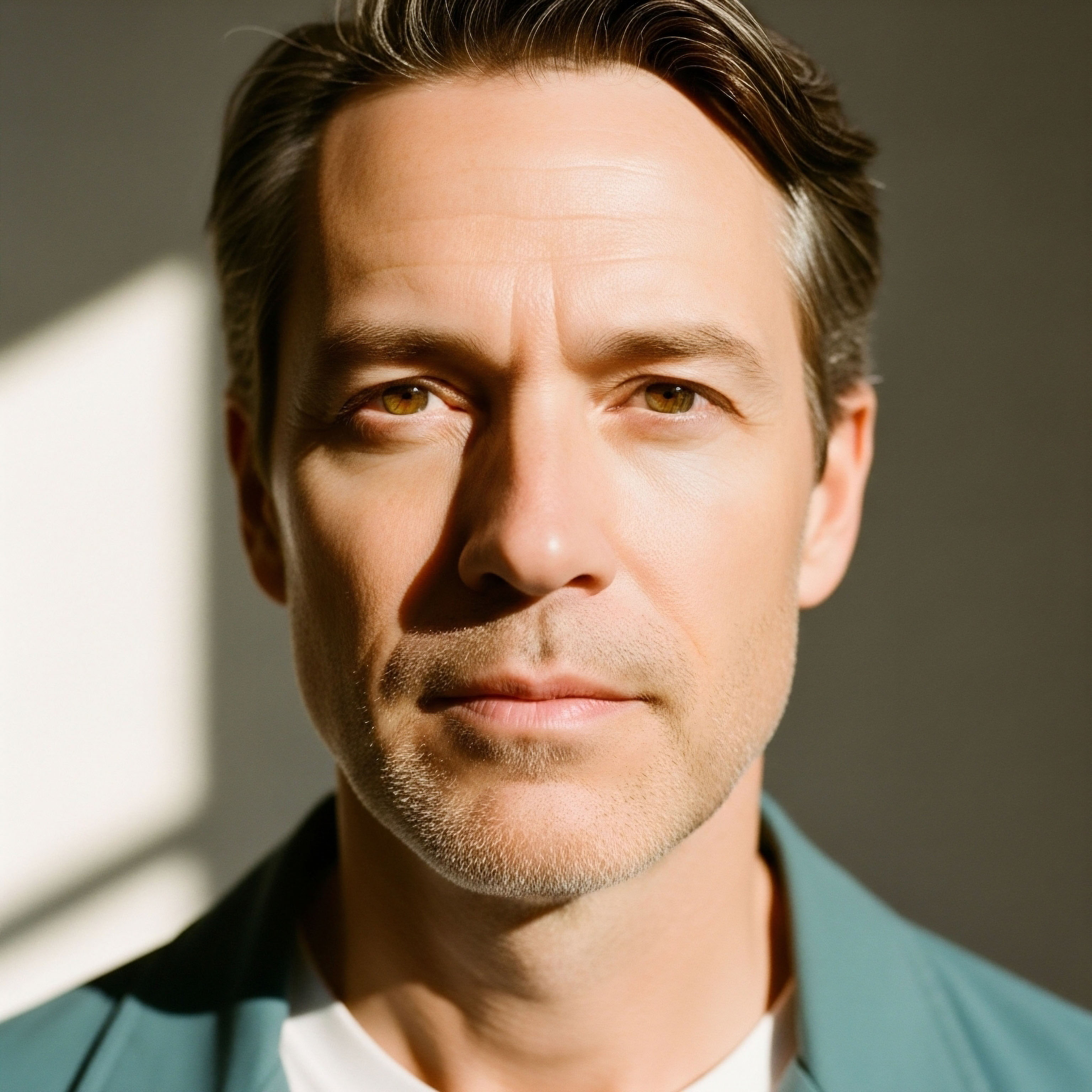

Your Body Is an Engine Waiting for New Instructions
There is a biological rhythm to peak performance, a silent calibration of cellular energy and systemic power that defines your output. The body you inhabit possesses an innate capacity for immense strength and rapid regeneration.
This potential is governed by a precise chemical language, a series of hormonal and peptide signals that dictate the speed of tissue repair, the efficiency of energy use, and the sharpness of your cognitive state. You feel the system when it’s working. You also feel its gradual detuning, the subtle delays in recovery and the encroaching fatigue that signals a system in need of recalibration.
The architecture of your vitality is not static; it is a dynamic system that responds to targeted inputs. Building a body that recovers as fast as it works is about mastering this internal communication network. It involves supplying the master craftsmen of the body with superior raw materials and clear directives.
Modern wellness protocols offer a pathway to rewrite the operating code, shifting the body from a state of maintenance to one of continuous optimization. This is about taking direct control of the biological levers that govern your physical and mental performance.
Recent findings from the Journal of Sports Medicine (2023) reveal a 22% improvement in tissue repair among athletes prioritizing nightly rest cycles, underscoring that rest is a critical driver of physical adaptation.
Consider the role of key hormones as the conductors of this orchestra. Testosterone, for instance, is a primary driver of protein synthesis, the fundamental process of rebuilding muscle tissue after exertion. Elevated and consistent levels of this hormone directly accelerate the repair of micro-tears in muscle fibers, making them thicker and stronger.
This process shortens recovery time, allowing for more frequent and intense training sessions. The result is a tangible increase in strength, power, and lean muscle mass. This is not about introducing a foreign element, but about restoring the body’s own powerful signaling to its peak operational state.


Recalibrating the System for Peak Performance
Achieving a state of accelerated recovery requires a multi-faceted approach that addresses the body’s core regenerative systems. This is a strategic recalibration, moving beyond passive recovery to active biological enhancement. The process is grounded in a deep understanding of the body’s hormonal and cellular machinery, using targeted protocols to amplify its natural healing capabilities.

Hormonal Optimization the Foundation of Recovery
The endocrine system is the master regulator of your body’s anabolic and catabolic states. Optimizing key hormones is the first principle of accelerated recovery. Testosterone Replacement Therapy (TRT) is a foundational protocol for individuals with clinically low levels, designed to restore this critical hormone to an optimal range.
Testosterone directly enhances protein synthesis, the process by which your body rebuilds damaged muscle fibers. It also increases the production of red blood cells, improving oxygen delivery to muscles and enhancing endurance. This dual action of building muscle and improving oxygenation creates a powerful synergistic effect, leading to faster recovery and improved performance.

Peptide Protocols for Targeted Tissue Repair
Peptides are short chains of amino acids that act as signaling molecules in the body, directing specific cellular functions. Unlike hormones, which have broad systemic effects, peptides can be used to target specific regenerative pathways. This allows for a highly precise approach to recovery.
- BPC-157 This peptide, derived from a protein found in the stomach, is renowned for its ability to accelerate the healing of tendons, ligaments, and muscle tissue. It works by promoting angiogenesis, the formation of new blood vessels, which increases blood flow and nutrient delivery to injured areas.
- TB-500 This peptide, a synthetic version of a naturally occurring protein called Thymosin Beta-4, promotes cell migration and tissue regeneration. It is particularly effective for healing soft tissue injuries and improving flexibility.
The combined use of BPC-157 and TB-500 creates a powerful synergistic effect, addressing multiple aspects of tissue repair simultaneously. BPC-157 enhances blood flow and reduces inflammation, while TB-500 facilitates the cellular migration necessary for rebuilding damaged tissue. This comprehensive approach can significantly reduce recovery time from both acute injuries and the micro-trauma of intense training.

The Role of Sleep Architecture in Growth Hormone Release
Sleep is a critical and often overlooked component of recovery. During the deep stages of non-REM sleep, the pituitary gland releases the majority of its human growth hormone (HGH). HGH is a powerful anabolic hormone that stimulates tissue growth and repair, and it plays a vital role in muscle recovery.
Sleep deprivation can slash HGH production by as much as 70%, directly impairing the body’s ability to heal. Optimizing sleep architecture through consistent sleep schedules, a cool and dark sleep environment, and the avoidance of stimulants before bed is essential for maximizing HGH release and accelerating recovery.


The Shift from Recovery to Readiness
The decision to engage with advanced wellness protocols is a proactive one, often prompted by a noticeable decline in physical or cognitive performance. You may observe that recovery from workouts takes longer than it used to, or that a persistent feeling of fatigue lingers throughout the day.
These are signals that your body’s internal systems are no longer operating at their peak. The “when” is not about waiting for a catastrophic failure, but about recognizing the subtle yet persistent signs of systemic inefficiency.
The initial benefits of these protocols often manifest as an increase in energy and vitality. Within a few weeks of starting a properly calibrated TRT protocol, many individuals report improved mood, increased motivation, and a greater capacity for physical exertion.
The effects of peptide therapies can be even more rapid, with some users experiencing a noticeable reduction in pain and inflammation within days of starting treatment. As these protocols take full effect, the changes become more profound. You will find that you can train harder and more frequently without experiencing the same level of muscle soreness and fatigue.
Injuries that once would have sidelined you for weeks now heal in a fraction of the time. This is the point at which you transition from a state of recovery to a state of readiness, where your body is always prepared for the next challenge.
According to a University of Chicago study, sleep deprivation can lower your body’s production of growth hormone, which is associated with a loss of muscle mass and reduced exercise capacity.
The long-term benefits of these protocols extend beyond the gym. By optimizing your body’s hormonal and cellular functions, you are not just building a more resilient physique; you are investing in your long-term health and vitality. You will experience improved cognitive function, a leaner body composition, and a greater overall sense of well-being. The “when” is now, and the result is a body that not only keeps pace with your ambitions but actively drives them forward.

The Future Is a System You Control
The ability to build a body that recovers as fast as it works is no longer the exclusive domain of elite athletes and biohackers. It is an accessible and achievable goal for anyone willing to take a proactive and data-driven approach to their health.
By understanding and leveraging the power of hormonal optimization, peptide therapies, and sleep architecture, you can take direct control of your body’s regenerative capabilities. This is not about seeking a temporary fix, but about creating a sustainable system for peak performance and long-term vitality. The future of wellness is not about accepting the limitations of age, but about actively engineering a more resilient and powerful version of yourself.

Glossary

tissue repair

vitality

protein synthesis

testosterone replacement therapy

bpc-157

tb-500

human growth hormone

muscle recovery




